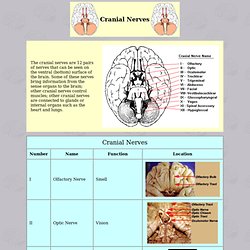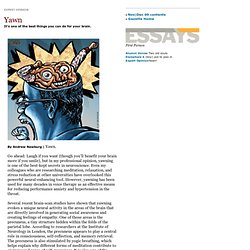

Blog de Eduard Punset. How to increase serotonin in the human brain without drugs. Cranial Nerves. Can't remember the names of the cranial nerves?

Here is a handy-dandy mnemonic for you: On Old Olympus Towering Top AFamous Vocal German Viewed Some Hops. The bold letters stand for: Brain Politics. SUBHEAD: Study suggests people with right wing views have a larger area of the brain associated with fear.

By Richard Alleyne on 28 December 2010 for the Telegraph -( Image above: Illustration of brain activity in meditation. From ( Your Backup Brain. There is, you may be happy to know, a guru of intestinal intelligence. And as improbable as it sounds, he just may be able to explain why you get depressed and anxious, dive for the peanut butter when you are stressed, and rely on "gut instincts," among many other matters of the mind. Meeting him turned out to be a gut-wrenching experience—literally. When a security guard at Columbia University's College of Physicians and Surgeons kept me waiting 45 minutes in the lobby while checking and rechecking my credentials, my stomach began churning like a washing machine. Institute of Cognitive Neuroscience. The brain&s silent majority - 2009 FALL - Stanford Medicine Magazine. When you have no clue, call it glue.

“Glia,” the Greek word for glue, was the name the pathologist Rudolph Virchow gave, back in 1856, to the gelatinous substance that forms the bulk of the brain. And it stuck. These days, scientists use it to denote the matter that accounts for 90 percent of the brain’s cells and more than half its volume — but, like the late comic Rodney Dangerfield, “can’t get no respect.” Neurons, the “talented tenth” of the human brain that hog the lion’s share of brain scientists’ attention, are indeed a work of evolutionary art. They’ve got a knack that glia lack: Their aptitude for high-speed, long-distance communication makes them the nervous system’s premier information processors.
“When the brain is injured, the neighborhood astrocytes go into a completely altered state.” We now know they’re doing much more. Certainly, it’s no stretch to imagine that knowing what glial cells do, and how they do it, could help explain brain disorders and how to cure them. Meditation found to increase brain size. Kris Snibbe/Harvard News Office Sara Lazar (center) talks to research assistant Michael Treadway and technologist Shruthi Chakrapami about the results of experiments showing that meditation can increase brain size.

People who meditate grow bigger brains than those who don’t. Researchers at Harvard, Yale, and the Massachusetts Institute of Technology have found the first evidence that meditation can alter the physical structure of our brains. Brain scans they conducted reveal that experienced meditators boasted increased thickness in parts of the brain that deal with attention and processing sensory input. In one area of gray matter, the thickening turns out to be more pronounced in older than in younger people. “Our data suggest that meditation practice can promote cortical plasticity in adults in areas important for cognitive and emotional processing and well-being,” says Sara Lazar, leader of the study and a psychologist at Harvard Medical School.
Controlling random thoughts. Penn Gazette. By Andrew Newburg | Yawn.

Go ahead: Laugh if you want (though you’ll benefit your brain more if you smile), but in my professional opinion, yawning is one of the best-kept secrets in neuroscience. Even my colleagues who are researching meditation, relaxation, and stress reduction at other universities have overlooked this powerful neural-enhancing tool. However, yawning has been used for many decades in voice therapy as an effective means for reducing performance anxiety and hypertension in the throat. Several recent brain-scan studies have shown that yawning evokes a unique neural activity in the areas of the brain that are directly involved in generating social awareness and creating feelings of empathy.
One of those areas is the precuneus, a tiny structure hidden within the folds of the parietal lobe. Why am I so insistent? As a young medical student, I was once “caught” yawning and actually scolded by my professor. My advice is simple. How to Trick Your Brain for Happiness. This month, we feature videos of a Greater Good presentation by Rick Hanson, the best-selling author and trailblazing psychologist.

In this excerpt from his talk, Dr. Hanson explains how we can take advantage of the brain’s natural “plasticity”—it’s ability to change shape over time. gobyg There’s this great line by Ani Tenzin Palmo, an English woman who spent 12 years in a cave in Tibet: “We do not know what a thought is, yet we’re thinking them all the time.” It’s true. In recent years, though, we have started to better understand the neural bases of states like happiness, gratitude, resilience, love, compassion, and so forth. Ultimately, what this can mean is that with proper practice, we can increasingly trick our neural machinery to cultivate positive states of mind.
But in order to understand how, you need to understand three important facts about the brain.